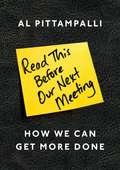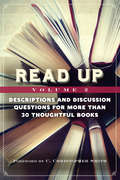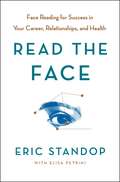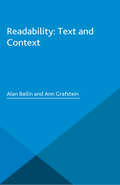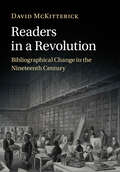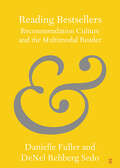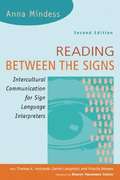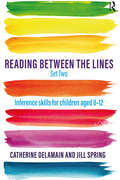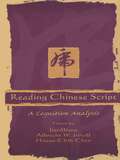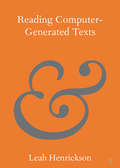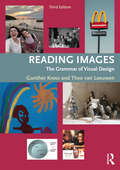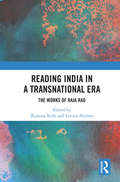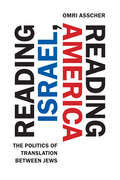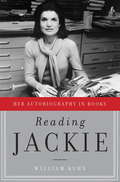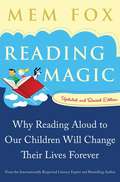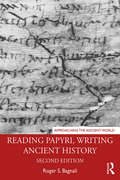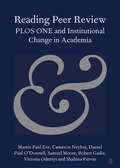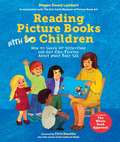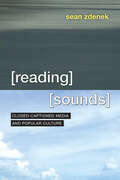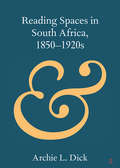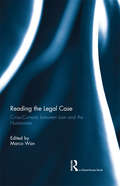- Table View
- List View
Read Me: 10 Lessons for Writing Great Copy
by Roger Horberry Gyles LingwoodIf you've ever struggled to craft a powerful message that really hits the spot, you'll know it's harder than it looks. Wouldn't it be helpful to have an expert on hand to explain how the professionals really do it? Better still, how about a whole range of writers ready to pass on their trade secrets?Well that's exactly what you'll find in the pages of this book. Think of it as a rocket-assisted launch for your writing career, structured over ten distinct lessons and illustrated with classic and contemporary international examples of the best copywriting. Designed to help anyone who works with words improve their writing, this book is packed with practical techniques and features effective exercises to pump up your persuasive powers.Includes inspiring contributions from professional writers, an in-depth look at the challenges involved in writing copy for brands and worked examples that cover writing for digital, brand storytelling, and packaging copy.
Read Me: 10 Lessons for Writing Great Copy
by Roger Horberry Gyles LingwoodIf you've ever struggled to craft a powerful message that really hits the spot, you'll know it's harder than it looks. Wouldn't it be helpful to have an expert on hand to explain how the professionals really do it? Better still, how about a whole range of writers ready to pass on their trade secrets?Well that's exactly what you'll find in the pages of this book. Think of it as a rocket-assisted launch for your writing career, structured over ten distinct lessons and illustrated with classic and contemporary international examples of the best copywriting. Designed to help anyone who works with words improve their writing, this book is packed with practical techniques and features effective exercises to pump up your persuasive powers.Includes inspiring contributions from professional writers, an in-depth look at the challenges involved in writing copy for brands and worked examples that cover writing for digital, brand storytelling and packaging copy.
Read This Before Our Next Meeting
by Al PittampalliFinally available in bookstores, an accessible guide on making meetings more effective, efficient, and worthy of attendingIf an operating room were as sloppily run as our meetings, patients would die. If a restaurant kitchen put as little planning into the meal as we put into our meetings, dinner would never be served. Worst of all, our meeting culture is changing how we focus, what we focus on, and what decisions we make. But there is an answer. A new kind of meeting--the Modern Meeting. Starting today, that's how we're going to do business. Culture change occurs when a transformational idea spreads to enough people. Like a virus that makes its way from person to person, spreading exponentially faster, so can the Modern Meeting and its seven critical principles of effective meeting management. Pittampalli shares examples of transforming workplaces by revamping the purpose of the meeting and a company's meeting culture. Simply put, he wants companies to stop wasting time. Read This Before Our Next Meeting is a call to action employees and their bosses need to create companies that do meaningful work. The status quo must go. Now. Before it's too late.
Read Up: Descriptions & Discussion Questions for More Than 30 Thoughtful Books
by C. Christopher Smith Lorraine CaultonRead Up, Volume 2.Read Up, Volume 2descriptions, discussion questions, author conversations or excerpts for more than 30 thoughtful books.Read UpRead Up
Read the Face: Face Reading for Success in Your Career, Relationships, and Health
by Elisa Petrini Eric StandopRelearn the intuitive language of face reading From birth, face is our first language. We are born face readers—knowing to seek out human features and faces from the moment our eyes open. We all have the intuitive ability to read and interpret the feelings and expressions of those around us. In Read the Face, master face reader Eric Standop unlocks the power of this innate human ability, sharing his own journey to become a face reading master, along with stories that illustrate the power of this unique language. Using a combination of three different schools of face reading, along with a scientific accuracy to detect the most fleeting microexpressions, Standop is able to read personality, character, emotions, and even the state of a person’s health—all from simply glancing at their face. The book is divided into sections focusing on specific ways that face reading can offer insight, such as Health, Love, Communication, Work and Success. The stories are accompanied by detailed black and white illustrations of faces, allowing readers to observe the same features that Standop interpreted. The final section of the book outlines the meanings of dozens of facial features and face shapes, so that readers can recognize their own innate intuitive powers and develop them. Read the Face is a guide to using the ancient art and science of face reading to go beyond the surface and create the boldest life possible.
Readability: Text and Context
by Alan Bailin Ann GrafsteinThis book explores what makes a book readable by bringing together the relevant literature and theories, and situating them within a unified account. It provides a single resource that offers a principled discussion of the issues and their applications.
Reader-Friendly Reports: A No-Nonsense Guide To Effective Writing For MBAs, Consultants, And Other Professionals
by Carter A. DanielFor more than 30 years, Carter A. Daniel has been teaching MBA students at Rutgers University the art of effective business communication with the aid of his eminently practical guide Reader-Friendly Reports. <P><P> Now available to the public for the first time, this beloved resource gives you everything you need to translate your hard-won figures, conclusions, and insights into concise and powerful reports. No definition of communication, no history, no theory, no diagrams Reader-Friendly Reports simply shows you how to: <P><P> Target your audience <br>Determine your purpose <br>Develop your points <br>Organize your ideas <br>Make smooth transitions <br>Conduct research <br>Illustrate with clear graphs and charts <P><P>Reader-Friendly Reports (the “Daniel Manual”) is the A to Z guide to ensuring you meet your first priority: making sure people can understand and remember your report from beginning to end.
Readers in a Revolution: Bibliographical Change in the Nineteenth Century
by David McKitterickThe mid-nineteenth century brought a revolution in popular and scholarly understandings of old and second-hand books. Manuals introduced new ideas and practices to increasing numbers of collectors, exhibitions offered opportunities previously unheard of, and scholars worked together to transform how the history of printing was understood. These dramatic changes would have profound consequences for bibliographical study and collecting, accompanied as they were by a proliferation in means of access. Many ideas arising during this time would even continue to exert their influence in the digitised arena of today. This book traces this revolution to its roots in commercial and personal ties between key players in England, France and beyond, illuminating how exhibitions, libraries, booksellers, scholars and popular writers all contributed to the modern world of book studies. For students and researchers, it offers an invaluable means of orientation in a field now once again undergoing deep and wide-ranging transformations.
Reading Bestsellers: Recommendation Culture and the Multimodal Reader (Elements in Publishing and Book Culture)
by Danielle Fuller DeNel Rehberg SedoReaders are essential agents in the production of bestsellers but bestsellers are not essential to readers' leisure pursuits. The starting point in this Element is readers' opinions about and their uses of bestselling fiction in English. Readers' relationships with bestsellers bring into view their practices of book selection, and their navigation of book recommendation culture. Based on three years of original research (2019–2021), including a quantitative survey with readers, interviews with social media influencers, and qualitative work with international Gen Z readers in a private Instagram chat space, the authors highlight three core actions contemporary multimodal readers make– choosing, connecting, and responding– in a transmedia era where on- and offline media practices co-exist. The contemporary multimodal reader, or the MMR3, they argue, illustrates the pervasiveness of recommendation culture, reliance on trusted others, and an ethic of responsiveness.
Reading Between The Signs: Intercultural Communication for Sign Language Interpreters
by Anna Mindess Thomas K. Holcomb Daniel Langholtz Priscilla Moyers Sharon Neumann SolowIn Reading Between the Signs: Intercultural Communication for Sign Language Interpreters, Anna Mindess provides a new perspective on a unique culture that is not widely understood-American Deaf culture. With the collaboration of three distinguished deaf consultants, Mindess explores the implications of cultural differences at the intersection of the deaf and hearing worlds. The book takes a practical approach with many useful suggestions for the sign language interpreter. Mindess provides several helpful dialogues between hearing and deaf Americans in a variety of situations to illustrate the problems that can arise as a result of cultural differences. The compounded difficulty of communicating with a deaf person from another country is addressed as well, with suggestions for ameliorating possible areas of misunderstanding. It also provides helpful information about advances in technology and the multicultural communities within the Deaf world. Reading Between the Signs is an invaluable tool for those interested in training as a sign language interpreter, but further, for anyone wishing to understand American Deaf culture. . A dazzling application of the tools of intercultural communication to illuminating Deaf and hearing cultures and their differences. . This is a book for everyone interested in Deaf culture. -Harlan Lane, author of When the Mind Hears and The Mask of Benevolence Adds a necessary dimension to understanding what sign language interpretation really entails-not the exchange of words for signs and vice versa but the translation of one view of life and all its meanings into another equally valid yet different view -William C. Stokoe, Former Professor Emeritus, Gallaudet University BRAVO The book is outstanding - well written, informative, and desperately needed in our field . -Jan Humphrey, Ed. D. Certified Interpreter, Interpreter Educator and Author of So You Want to Be an Interpreter?A must-read An enlightening book. a defining document in the literature of Deaf culture. -Eileen Forestal, Professor, ASL Studies and Interpreting Training, Union County College Contents Foreword by Sharon Neumann So low Preface Acknowledgments Part One: Background 1 Introduction 2 The Study of Culture 3 Selected Topics in Intercultural Communication 4 Do Americans Really Have a Culture? 5 American Deaf Culture 6 Multicultural Deaf Culture 7 Culture, Change, and Technology Part Two: Practical Applications 8 The Impact of Cultural Differences on Interpreting Situations 9 Multicultural Interpreting Challenges 10 The Interpreter's Role and Responsibilities 11 Techniques for Cultural Adjustments12 Interpreting in a Virtual World 13 Cultural Sensitivity Shouldn't End at Five O'Clock Afterword by Dr. Thomas K. Holcomb Bibliography About the Author and Contributors Index.
Reading Between the Lines Set Two: Inference skills for children aged 8 – 12
by Catherine Delamain Jill SpringReading Between the Lines Set Two is a sequel to the popular Reading Between the Lines. It is a resource book for teachers, teaching assistants, SENCOs and Speech and Language Therapists who need to support the development of inference skills in children aged 8–12. These unique guides offer accessible and easy-to-use material specifically targeted to improve inference, which is a crucial element in understanding spoken and written language. The book provides 370 engaging texts themed around different areas such as place and occupation, and includes short stories about everyday events, magic and adventure. Each short text is accompanied by guiding questions and is carefully graded to allow students to gradually progress from more simple texts with highlighted clues onto more challenging scenarios which will require higher level inferencing skills. Containing handy photocopiable material, this guide can be used with whole classes, small groups or individual children. It will be particularly valuable to professionals working with children who have Autism Spectrum Disorders or Speech, Language and Communication Needs, who need particular support with inference as they develop their broader social communication skills.
Reading Chinese Script: A Cognitive Analysis
by Jian Wang Hsuan-Chih Chen Albrecht W. InhoffThis volume uses unique properties of Chinese script to focus on morphological analyses during the character and word recognition process, though some of the reported work also pertains to the use of phonological information. In addition, this volume contains work on syntactic and pragmatic processes during sentence reading and three chapters that examine on-line processes. A comprehensive appraisal of cognitive processes during the reading of Chinese script that includes studies conducted by leading researchers from within and outside the mainland, this volume will be of interest to all those studying reading and visual symbol processing.
Reading Computer-Generated Texts (Elements in Publishing and Book Culture)
by Leah HenricksonNatural language generation (NLG) is the process wherein computers produce output in readable human languages. Such output takes many forms, including news articles, sports reports, prose fiction, and poetry. These computer-generated texts are often indistinguishable from human-written texts, and they are increasingly prevalent. NLG is here, and it is everywhere. However, readers are often unaware that what they are reading has been computer-generated. This Element considers how NLG conforms to and confronts traditional understandings of authorship and what it means to be a reader. It argues that conventional conceptions of authorship, as well as of reader responsibility, change in instances of NLG. What is the social value of a computer-generated text? What does NLG mean for modern writing, publishing, and reading practices? Can an NLG system be considered an author? This Element explores such question, while presenting a theoretical basis for future studies.
Reading Images: The Grammar of Visual Design
by Gunther Kress Theo van LeeuwenThis third edition of the landmark textbook Reading Images builds on its reputation as the first systematic and comprehensive account of the grammar of visual design. Drawing on an enormous range of examples from children's drawings to textbook illustrations, photo-journalism to fine art, as well as three-dimensional forms such as sculpture and toys, the authors examine the ways in which images communicate meaning. Features of this fully updated third edition include: new material on diagrams and data visualization a new approach to the theory of 'modality' a discussion of how images and their uses have changed since the first edition examples from a wide range of digital media including websites, social media, I-phone interfaces and computer games ideas on the future of visual communication. Reading Images presents a detailed outline of the 'grammar' of visual design and provides the reader with an invaluable 'tool-kit' for reading images in their contemporary multimodal settings. A must for students and scholars of communication, linguistics, design studies, media studies and the arts.
Reading India in a Transnational Era: The Works of Raja Rao
by Rumina Sethi; Letizia AlternoThis anthology demonstrates the significance of Raja Rao’s writing in the broader spectrum of anti-colonial, postcolonial and diasporic writing in the 20th Century. In addition to highlighting Rao’s significant presence in Indian writing, the volume presents a range of previously unpublished material which contextualises Rao’s work within 20th-century modernist, postmodernist and postcolonial trends. Exploring both his fictional and non-fictional works, Reading India in a Transnational Era engages with issues of subaltern agency and national belonging, authenticity, subjectivity, internationalism, multicultural politics, postcolonialism and literary and cultural representation through language and translation. A literary volume that discusses gender and identity on both socio-political grounds, apart from dealing with Rao’s linguistic experimentations in a transnational era, this book will be of interest among scholars and researchers of English, postcolonial and world literature, cultural theory and Asian studies.
Reading Israel, Reading America: The Politics of Translation between Jews (Stanford Studies in Jewish History and Culture)
by Omri AsscherAmerican and Israeli Jews have historically clashed over the contours of Jewish identity, and their experience of modern Jewish life has been radically different. As Philip Roth put it, they are the "heirs jointly of a drastically bifurcated legacy." But what happens when the encounter between American and Israeli Jewishness takes place in literary form—when Jewish American novels make aliyah, or when Israeli novels are imported for consumption by the diaspora? Reading Israel, Reading America explores the politics of translation as it shapes the understandings and misunderstandings of Israeli literature in the United States and American Jewish literature in Israel. Engaging in close readings of translations of iconic novels by the likes of Philip Roth, Saul Bellow, Bernard Malamud, Amos Oz, A. B. Yehoshua, and Yoram Kaniuk—in particular, the ideologically motivated omissions and additions in the translations, and the works' reception by reviewers and public intellectuals—Asscher decodes the literary encounter between Israeli and American Jews. These discrepancies demarcate an ongoing cultural dialogue around representations of violence, ethics, Zionism, diaspora, and the boundaries between Jews and non-Jews. Navigating the disputes between these "rival siblings" of the Jewish world, Asscher provocatively untangles the cultural relations between Israeli and American Jews.
Reading Jackie: Her Autobiography in Books
by William KuhnJacqueline Kennedy Onassis never wrote a memoir, but she told her life story and revealed herself in intimate ways through the nearly 100 books she brought into print during the last two decades of her life as an editor at Viking and Doubleday. Based on archives and interviews with Jackie's authors, colleagues, and friends,Reading Jackiemines this significant period of her life to reveal both the serious and the mischievous woman underneath the glamorous public image. Though Jackie had a reputation for avoiding publicity, she willingly courted controversy in her books. She was the first editor to commission a commercially-successful book telling the story of Thomas Jefferson#x19;s relationship with his female slave. Her publication of Gelsey Kirkland's attack on dance icon George Balanchine caused another storm. Jackie rarely spoke of her personal life, but many of her books ran parallel to, echoed, and emerged from her own experience. She was the editor behind bestsellers on the assassinations of Tsar Nicholas II and John Lennon, and in another book she paid tribute to the allure of Marilyn Monroe and Maria Callas. Her other projects take us into territory she knew well: journeys to Egypt and India, explorations of the mysteries of female beauty and media exploitation, into the minds of photographers, art historians, and the designers at Tiffany & Co. Many Americans regarded Jackie as the paragon of grace, but few knew her as the woman sitting on her office floor laying out illustrations, or flying to California to persuade Michael Jackson to write his autobiography. Reading Jackieprovides a compelling behind-the-scenes look at Jackie at work: how she commissioned books and nurtured authors, as well as how she helped to shape stories that spoke to her strongly. Jackie is remembered today for her marriages to JFK and to Aristotle Onassis, but her real legacy is the books that reveal the tastes, recollections, and passions of an independent woman. From the Hardcover edition.
Reading Magic: Why Reading Aloud to Our Children Will Change Their Lives Forever
by Mem FoxWith passion and humor, Fox speaks of when, where, and why to read aloud and demonstrates how to read aloud to best effect and get the most out of a read-aloud session. She discusses the three secrets of reading, offers guidance on defining and choosing good books.
Reading Papyri, Writing Ancient History (Approaching the Ancient World)
by Roger S. BagnallSince its first publication in 1995, Reading Papyri, Writing Ancient History has proved to be an invaluable resource for students of the ancient world looking to integrate papyrological evidence into their research. In the quarter century since its publication, changes in the research environment have affected papyrology like other fields. Although the core philological methods of the field remain in place, the field has increasingly embraced languages other than Greek and Latin, with considerable impact on the Hellenistic and Late Antique periods. Digital tools have increased the ease and speed of access, with profound effects on research choices, and digital imaging and materiality studies have brought questions about the physical form of written materials to the fore. In this fully revised new edition, Bagnall adds to the previous analysis a portrait of how the use of papyri for historical research has developed during recent decades. Updated with the latest research and insights from the author, the volume guides historians in how to use these scattered and often badly damaged documents, and to interpret them in order to create a full and diverse picture of ancient society and culture. This second edition of Reading Papyri, Writing Ancient History continues to offer students and researchers of the ancient world a critical resource in navigating how to use these ancient texts in their research.
Reading Peer Review (Elements in Publishing and Book Culture)
by Samuel Moore Martin Paul Eve Cameron Neylon Daniel Paul O'Donnell Robert Gadie Victoria Odeniyi Shahina ParvinThis Element describes for the first time the database of peer review reports at PLOS ONE, the largest scientific journal in the world, to which the authors had unique access. Specifically, this Element presents the background contexts and histories of peer review, the data-handling sensitivities of this type of research, the typical properties of reports in the journal to which the authors had access, a taxonomy of the reports, and their sentiment arcs. This unique work thereby yields a compelling and unprecedented set of insights into the evolving state of peer review in the twenty-first century, at a crucial political moment for the transformation of science. It also, though, presents a study in radicalism and the ways in which PLOS's vision for science can be said to have effected change in the ultra-conservative contemporary university. This title is also available as Open Access on Cambridge Core.
Reading Picture Books with Children
by Megan Dowd LambertA new, interactive approach to storytime, The Whole Book Approach was developed in conjunction with the Eric Carle Museum of Picture Book Art and expert author Megan Dowd Lambert's graduate work in children's literature at Simmons College, offering a practical guide for reshaping storytime and getting kids to think with their eyes. Traditional storytime often offers a passive experience for kids, but the Whole Book approach asks the youngest of readers to ponder all aspects of a picture book and to use their critical thinking skills. Using classic examples, Megan asks kids to think about why the trim size of Ludwig Bemelman's Madeline is so generous, or why the typeset in David Wiesner's Caldecott winner,The Three Pigs, appears to twist around the page, or why books like Chris Van Allsburg's The Polar Express and Eric Carle's The Very Hungry Caterpillar are printed landscape instead of portrait. The dynamic discussions that result from this shared reading style range from the profound to the hilarious and will inspire adults to make children's responses to text, art, and design an essential part of storytime.
Reading Sounds: Closed-Captioned Media and Popular Culture
by Sean ZdenekImagine a common movie scene: a hero confronts a villain. Captioning such a moment would at first glance seem as basic as transcribing the dialogue. But consider the choices involved: How do you convey the sarcasm in a comeback? Do you include a henchman's muttering in the background? Does the villain emit a scream, a grunt, or a howl as he goes down? And how do you note a gunshot without spoiling the scene? These are the choices closed captioners face every day. Captioners must decide whether and how to describe background noises, accents, laughter, musical cues, and even silences. When captioners describe a sound--or choose to ignore it--they are applying their own subjective interpretations to otherwise objective noises, creating meaning that does not necessarily exist in the soundtrack or the script. Reading Sounds looks at closed-captioning as a potent source of meaning in rhetorical analysis. Through nine engrossing chapters, Sean Zdenek demonstrates how the choices captioners make affect the way deaf and hard of hearing viewers experience media. He draws on hundreds of real-life examples, as well as interviews with both professional captioners and regular viewers of closed captioning. Zdenek's analysis is an engrossing look at how we make the audible visible, one that proves that better standards for closed captioning create a better entertainment experience for all viewers.
Reading South Vietnam's Writers: The Reception of Western Thought in Journalism and Literature (Global Vietnam: Across Time, Space and Community)
by Chi P. Pham Thomas EngelbertThis edited book examines how South Vietnam’s (formerly the Republic of Vietnam 1955-1975) literary and journalistic writers were perceived and - potentially - influenced by Western thought, led by thinkers such as Jean-Paul Sartre, Franz Kafka, Sigmund Freud, Thomas Mann, Martin Heidegger, Hermann Hesse, Edmund Husserl, Stefan Zweig, Graham Greene, and Somerset Maugham. The book reveals the dynamism and diversity of Western thought in individual literary texts, as well as among the authors themselves. The volume considers how writers and their texts engaged with issues that are socially, culturally, politically, and philosophically significant to Vietnam and beyond, past and present. This approach to South Vietnam’s literary and journalistic tradition enables an alternative plural, inclusive view of the significance of these texts, which are shown to be neither exclusively anti-Communist nor “bourgeois individualist” (cá nhân tiểu tư sản), as they have so often been interpreted both in and outside of Vietnam. Such an interpretation problematically retains the marginal position of South Vietnam’s literature in mainstream Vietnamese literature, and in the literatures of the host countries where these Vietnamese authors have migrated, settled, and continued to write following the 'Fall of Saigon'. This volume presents itself as a key text for those studying Asian and postcolonial literatures, as well as scholars in the humanities researching Vietnam – its history, politics, society, and culture.
Reading Spaces in South Africa, 1850–1920s (Elements in Publishing and Book Culture)
by Archie L. DickVoluntary societies and government initiatives stimulated the growth of reading communities in South Africa in the second half of the nineteenth century. A system of Parliamentary grants to establish public libraries in country towns and villages nurtured a lively reading culture. A condition was that the library should be open free-of-charge to the general public. This became one more reading space, and others included book societies, reading societies, literary societies, debating societies, mechanics institutes, and mutual improvement societies. This Element explains how reading communities used these spaces to promote cultural and literary development in a unique ethos of improvement, and to raise political awareness in South Africa's colonial transition to a Union government and racial segregation.
Reading The Legal Case: Cross-Currents between Law and the Humanities
by Marco WanThis volume examines the nature, function, development and epistemological assumptions of the legal case in an interdisciplinary context. Using the question of ‘reading’ as a guiding principle, it opens up new ways of understanding case law and the doctrine of precedent by bringing the law into dialogue with the humanities. What happens when a legal case is read not only by lawyers, but by literary critics, by linguists, by philosophers, or by historians? How do film makers and writers adapt and transform legal cases in their work? How might one interpret fiction in the context of the historical development of the common law? The essays in this volume test the boundaries of the legal case as a genre by inviting perspectives from other disciplines, and in doing so also raise more fundamental questions of what constitutes law and legal thinking. This book will be of interest to anyone seeking a better understanding of the common law, the humanities, and the intersection between them.

